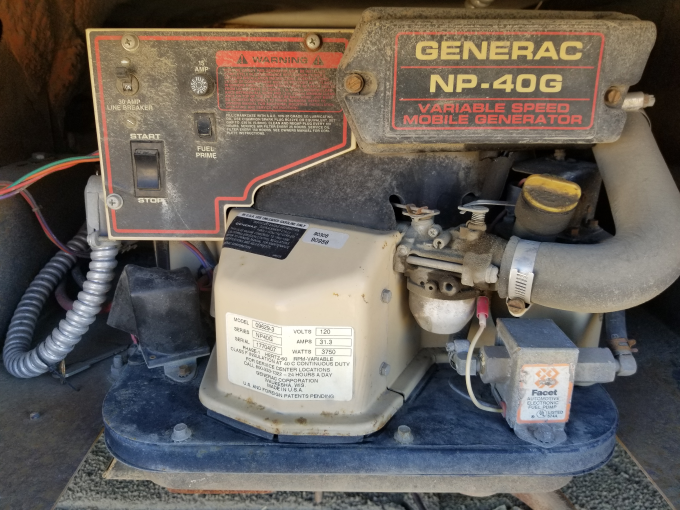
When Vanessa and I first started tossing around the idea of selling our fourplex and moving across the country, I was basically clueless when it came to RVing. Well, I was clueless about a lot of things (still am), but that’s not important here.
I remember when I was 8 or 9 years old, I got to travel over part of the Alcan with my Grandparents in a big class A motorhome. Other than that however, I hadn’t really had any practical experience with RVing up to this point in my life.
As Vanessa and I became more and more confident in our decision to move away from Alaska, we realized we were going to need some sort of RV, and I was going to have to learn all about how you’re supposed to “do the RVing”. I really didn’t have any idea.
Was it Going to be Hard Learning How RVs Worked?
I was intrigued by learning the ins and outs of the RV lifestyle. Especially how you go about running appliances, or how long batteries last, and what kind of batteries you would need for that matter.
Honestly, it seemed like a bit of a daunting task to learn, so whenever I would get the chance, I would ask Vanessa’s dad all kinds of questions related to the RV lifestyle. After all, he’d been doing it for years and he knows a lot about motorhomes in general.
That was a big help, but everything didn’t truly click until we made it to Tuscon, Arizona where they were staying. He walked us through all the different aspects of using our class C motorhome. We learned about how the water system works, how the different holding tanks work, how to drain them, and many other things as well.
Electical Basics for Getting Started in RVing
What I specifically want to talk about in this post is what you can expect when using electricity in your RV. What kind of limitations you might have and what sort of expectations you should have. I’ll mostly be focusing on our class C but it will be very similar regardless of whether you have a tow trailer, a class A, or a class C.
Let me begin by saying that being plugged-in is by far the best. Buying electricity is much cheaper than producing it yourself. But since we’re talking about boondocking here, plugging in probably won’t be an option. To keep things simple, I’m going to focus on using a single house battery along with a generator.
Starting Batteries
Our ’97 class C motorhome came with two different batteries and a 3750 watt generator.
The first is a regular starting battery. That’s to say, it’s the same kind of battery that your car or truck uses to turn the engine over. It does the exact same thing here. You can see it in the picture below.
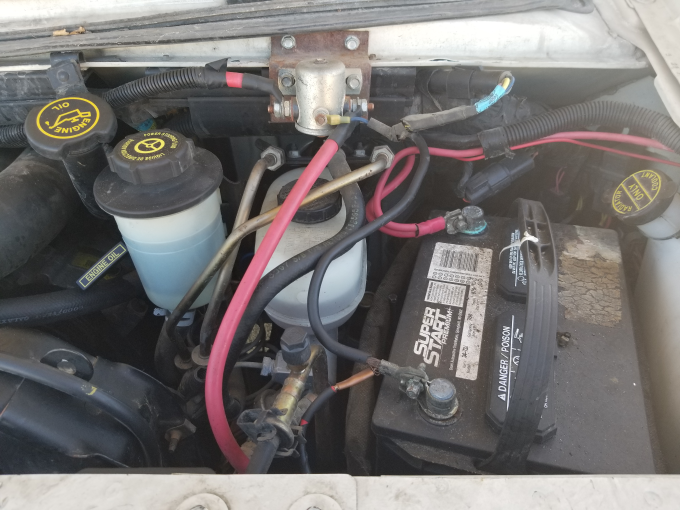
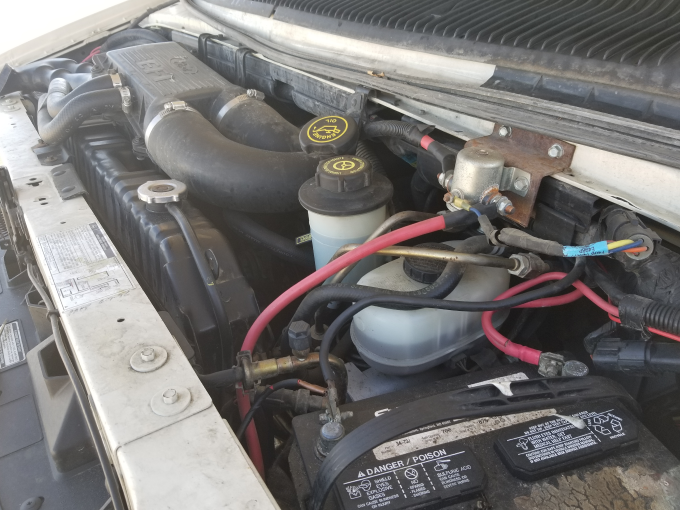
Starting batteries are designed with thinner plates inside to provide more surface area which allows them to deliver a very large amount of electricity over a very short time. The starter requires a huge amount of amperage and it needs it quick, so that’s exactly what these batteries are made to do.
You don’t want to drained these batteries below 80% charge. At that point they should be considered fully discharged. If you continue to drop below that threshold, it will cause irreversible damage to the thin lead plates inside your battery through excessive sulfation.
Deep Cycle Batteries
The second type of battery we have is called a house battery or a coach battery. When you aren’t hooked up to an external source of electricity, or when you aren’t running your generator, this is the battery that will power your lights, water pump, and heater fan. This most often will be a deep cycle battery, golf cart battery, or some form of hybrid between a starting battery and a deep cycle battery.
Golf cart batteries are very rugged and are designed to withstand deeper discharges better than a starting battery. The same goes for a deep cycle battery.
The deep cycle battery will perform best, and last you the longest, if it’s recharged when it reaches 50%. They are designed to provide a lower but constant amount of electricity over longer periods of time.
If you are interested in the science behind how batteries operate or are curious to learn more about electricity in general, I can recommend a book that I’ve used firsthand and have found to be very informative. You can click the image on the right and it will take you to Amazon to learn more. It covers basically any topic you can imagine when it comes to electricity.
Below is a picture of our deep cycle battery. It provides power for our lights, water pump, and heater fan when we’re boondocking and the generator isn’t running. I personally would prefer to have more than just a single battery, but we simply don’t have enough room under the hood. Unfortunately this limited space also means I can’t even switch to having a single golf cart battery because they are typically taller than what would fit.
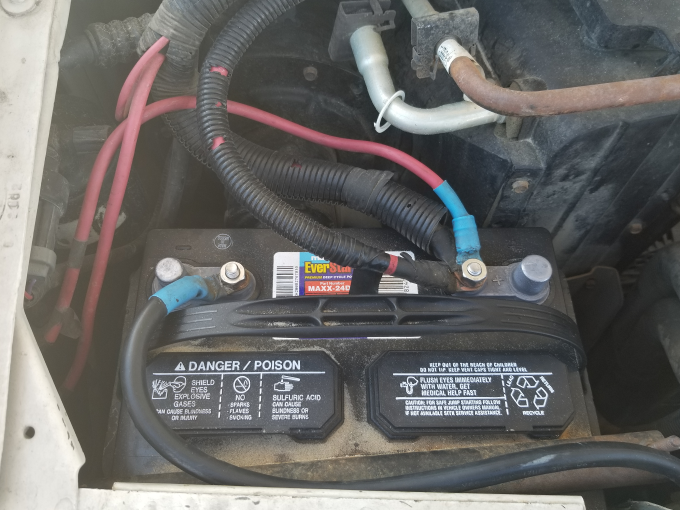
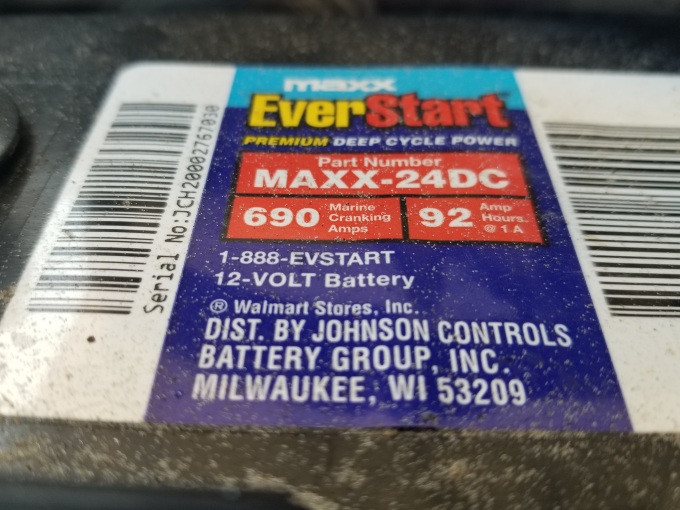
Deep cycle batteries have thicker and stronger lead plates (but also less surface area on the plates). This makes them less prone than the plates in starting batteries to warping as sulfation occurs during discharge. You don’t want to use a starting battery as your coach/house battery. If you do, you’ll be going through a lot of batteries.
Our deep cycle battery is under our hood on the opposite side from our starting battery. It gets charged whenever our motorhome is running. It also gets charged when our generator is running and to a small degree when we are plugged into land power.
The Basics About Electrical Use For An RV Newbie
To start off , you should know that unless you have your generator running, or you’re plugged into some form of fixed power, say at an RV park or an external outlet at a friend’s house, you won’t be able to use any outlets you have in your RV. So you most likely won’t be able to watch TV or recharge your laptop if you’re not plugged in or running your generator.
Below is a picture of the power cord for our RV.
Also it’s quite embarrassing to admit, but when we first got our RV, we couldn’t figure out why we weren’t getting any power to our microwave and power outlets even though the generator was running. Well…it turns out you need to actually plug yourself into the generator.
Otherwise it’s just running and all that electricity is being wasted. I’ll show you what I mean in the picture below.
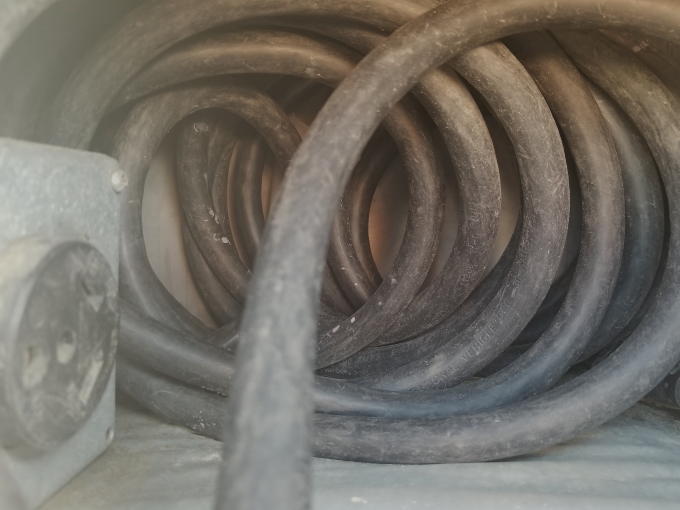
Because of the large energy requirements of your microwave and AC unit, you will need to run your generator if you plan on using either one of them.
Using Electricity While Boondocking Versus Using Electricity While Hooked Up
So your RV has 2 electrical systems: a 12 volt system, and a 120 volt system. The 12 volt system is usually powered by a deep cycle battery or multiple deep cycle batteries (as we discussed earlier) which power things like the start-up of your furnace, refrigerator, and hot water heater. This system also powers your water pump (very important if you enjoy running water for flushing the toilet and taking showers) and most, if not all, of the lights in your RV.
The 120 volt system on the other hand is powered by plugging your RV into an electrical hookup or running your generator. This system powers your electrical outlets, your microwave, and your AC unit.
When you plug into an electrical source whether it be the electrical pedestal at an RV park or some other place, your 12 volt battery/batteries will charge. When boondocking, or you otherwise don’t have access to a permanent form of of electricity, your deep cycle battery or batteries (house battery) will power anything in your RV that runs on 12 volts.
As I stated earlier, you can install an inverter which will convert your 12 volt battery’s direct current to 120 volt ac which will power your outlets so you can use your TV or anything else that requires 120 volts of alternating current.
How to Deal With Different Amp Outlets
Nearly every RV will come with a power cord which will allow you to plug into the electrical hookups found in most RV parks and some campgrounds. You will typically find a 30 amp and a 50 amp plugin. A 30 amp plug has 3 prongs like you can see in the picture below. It’s the actual plug from our RV.
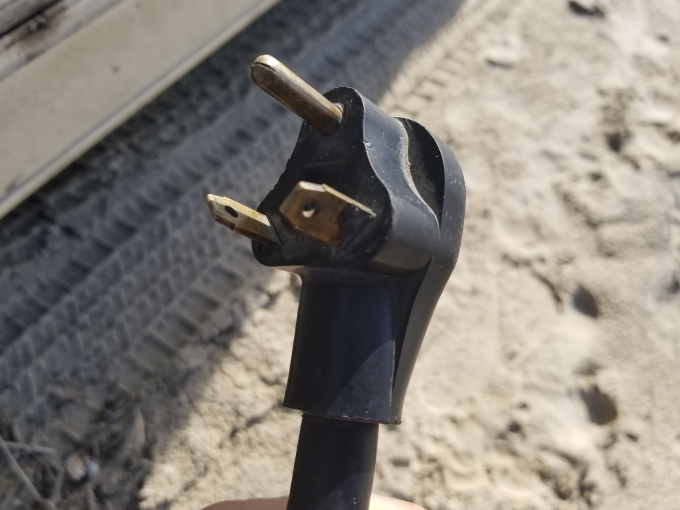
And in this picture you can see a 50 amp plug. They are larger and have 4 prongs as opposed to the 30 amp’s 3 prongs.
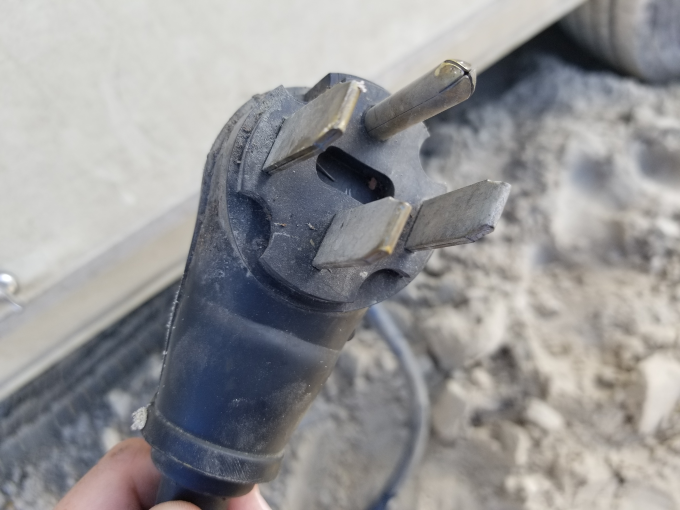
Finally, you can purchase adapters (if your RV doesn’t come with any) like the one in the picture below. You can change between 50 amp, 30 amp, 20 amp, and 15 amp.
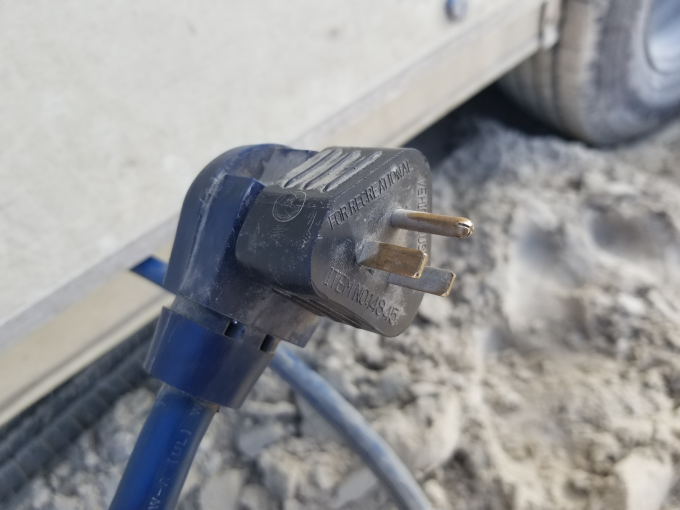
It should go without saying that if you have a 50 amp hookup, you will have the capability to use a lot more electricity at one time than you could with a 30 amp hookup.
Most RV parks have electrical hookups for both 30 and 50 amp cords. I’ve seen some parks that even have 20 amp plug-ins as well. So I would recommend spending a little money to purchase an adapter that will allow you to go from a 50 amp plug down to a 30 amp plug if your default RV power cord is setup to plug into a 50 amp hookup only.
Just be mindful of the fact that if you are adapting your amperage from 50 down to 30, you won’t have as much electricity to use. And if you’re concerned about voltage drop, make sure you use the shortest extension cords and adapters you can find.
A Couple Tips I’ve Learned Along the Way
Most RVs have a display panel that lets you monitor the various levels of things such as your fresh water supply. One of these things should let you know how charged your house battery is. Most have a panel with a battery gauge that have the letters: C, G, F, L.
I had no clue what these meant when I first began RVing. But I soon figured it out and I learned that you should keep an eye on this indicator. The letters stand for C = charging/charged, G = Good, F = Fair, and L = Low.
The light will be on C when the RV is plugged into electrical hookups or the generator is running.
It will be on G immediately after electricity is turned off or the generator is not running anymore.
Eventually it will reach F, for fair, after some use throughout the day.
Finally, if the battery has not been charged at some point, and the battery is continually being discharged throughout the day, the light will indicate L for low.
Try to avoid letting it get to L. A good rule of thumb is that if it reads F while something such as the water pump is on but then returns to G after nothing else is drawing power from it, it’s still good and doesn’t need to be charged.
However, if it stays on F after whatever is drawing power from it is turned off, you might want to think about turning the generator on to charge the battery.
I’ve found that our battery lasts much longer between charges when I turn the water pump off unless I need to run water at that moment. I suspect we have a little leak somewhere which periodically makes the water pump turn on and slowly drains our battery.
Another thing I highly recommend doing if you have an older RV like we do, is to go through and begin replacing those old bulbs with brand new LED bulbs. They’re a bit more expensive upfront, but they’ll drastically reduce the amount of energy being drawn from the battery, keeping it fuller for much longer. Plus, they flat out last so much longer.
Also, keep in mind that the fan in the heater will drain your battery pretty quick if you’re in cold weather. So if you think you might be boondocking in colder weather, you should think about adding additional batteries to your setup or be prepared to wake up in the middle of the night to run your generator.
What About Solar?
There is one other, relatively easy, form of generating electricity. If you have solar panels, you can use them in addition to an inverter and that will change the electricity output from your 12 volt direct current battery to the 120 volt alternating current that your outlets run on.
Solar panels do require a little bit of an upfront investment, but they are a great option if you think you might enjoy boondocking for long periods of time as they basically eliminate the need to plugin. I’m not going to go into any more details about solar here, however, and I just wanted to stick with the basics for now.
Hopefully, if you’re new to RVing this guide will be of some use to you as you go about your travels. Obviously, I might have missed something, so if you have any questions, I encourage you to ask them in the comments below and I will try and answer as soon as possible.
Thanks and safe travels!



Post a comment